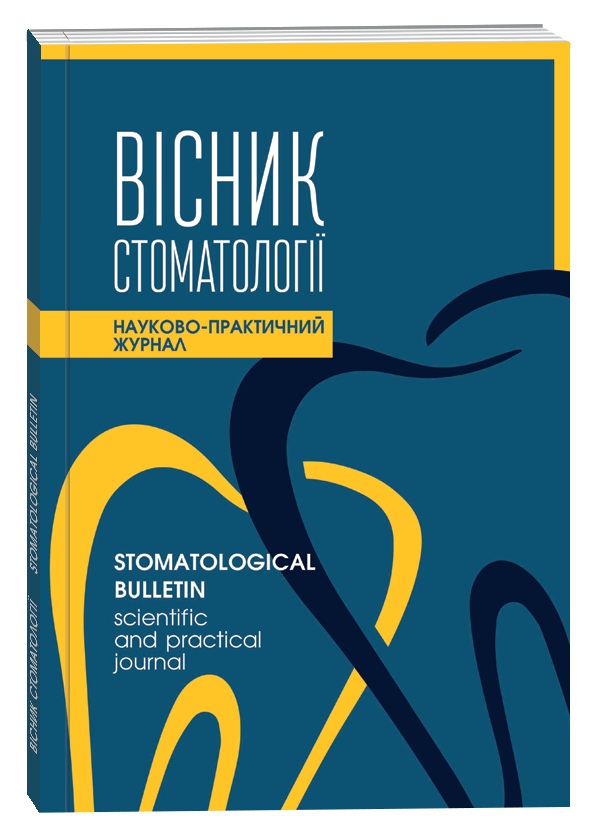THE INFLUENCE OF PLASTIC AND MEDICATION THERAPY ON THE ARCHITECTURAL DISORDERS OF THE VESTIBULE OF THE MOUTH
DOI:
https://doi.org/10.35220/2078-8916-2023-49-3.15Keywords:
the vestibule of the mouth, buccal frenulum, acquired maxillomandibular anomalies, frenuloplasticAbstract
The aim of the study. The aim is to improve the effectiveness of comprehensive treatment of patients with pathological occlusion on the background of violations of the architecture of the vestibule of the mouth. Research methods. 30 patients with acquired maxillomandibular anomalies and buccal frenulum were examined and treated. Patients were aged 9-12 years and divided into two groups. They were randomized by age and gender. The presence of violation of the architecture of the vestibule of the mouth was determined: the height of attachment of the lips, buccal frenulum, the presence of a shallow vestibule of the mouth. A rheographic and cytomorphometric examination was conducted. The condition of the surgical wound and the processes of postoperative scar formation were studied. All patients had plastic of the architecture of the vestibule of the mouth by the classical method, where the surgical wound is healed by secondary tension. Group I patients (15 people) were prescribed chlorhexidine-denta in the postoperative period according to the instructions. Patients of the II group (15 people) were prescribed chlorhexedine-denta and gengigel according to the instructions. Scientific novelty. Before treatment, all patients were diagnosed with a violation of the architecture of the vestibule of the mouth. It was manifested by highly attached buccal frenulum in the area of canines, premolars, and lip frenulum on the mandible (less than 5 mm); low attached buccal frenulum in the area of canines, premolars and lip frenulum on the maxilla (less than 5mm). Before treatment, all patients were diagnosed with a blood supply deficiency in the tissues of the vestibule of the mouth according to cytomorphometric and rheographic indicators. The treatment performed indicates a significant difference in clinical and laboratory indicators in I and II group of patients. The use of a drugs based on hyaluronic acid in the postoperative period indicates the formation of a normortophic scar, the absence of relapses and formations of gum recession in the area of canines and premolars, the normalization of clinical and laboratory indicators. The obtained data are significantly different from the indicators in I group of patients (р<0.05). Conclusions. Studying the anatomical features of the vestibule of the mouth in patients with acquired maxillomandibular anomalies is a necessary stage of complex treatment. Since the patients with disorders of the architecture of the vestibule of the mouth have a deficiency of blood supply and changes in cytomorphometric characteristics. Surgical correction of violations of the architectonics of the vestibule of the mouth is an important step in the complex treatment of patients with acquired maxillomandibular anomalies against the background of violations of the architectonics of the vestibule of the mouth. Reorgaphic research after plastic of the buccal frenulum is characterized by positive changes in the qualitative and quantitative characteristics of rheograms. Early and longterm results of clinical and cytomorphometric research indicate the feasibility of using preparations based on hyaluronic acid in the postoperative period. The obtained data in the II group of patients is significantly different from the indicators in I group of patients (p<0.05).
References
Al-Shammari NM, Shafshak SM and Ali MS. Effect of 0.8% Hyaluronic acid in conventional treatment of moderate to severe chronic periodontitis. J Contemp Dent Pract. 2008; 19: 527–534.
Базунова І.В. Вплив стану присінка рота в осіб молодого віку на вибір тактики стоматологічних втручань. … к.мед.н: 14.00.21 «Стоматологія». Полтава, 2007. 159 с.
Cugini MA, Haffajee AD, Smith C, Kent RL Jr and Socransky SS. The effect of scaling and root planing on the clinical and microbiological parameter of periodontal diseases: 12-month results. J Clin Periodontol. 2020; 27:30-36.
Eliezer M, Imber JC, Sculean A, Pandis N and Teich S. Hyaluronic acid as adjunctive to non-surgical and surgical periodontal therapy: A systematic review and meta-analysis. Clin Oral Invest. 2019; 23:3423-3435.
Forthofer RN. Biostatistics: A Guide to Design, Analysis, and Discovery. Amsterdam: Elsevier Academic Press, 2007: 502.
Головко НВ. Профілактика зубощелепних аномалій. Вінниця: Нова книга, 2005: 272.
Ibraheem W, Jedaiba WH, Alnami AM, Hussain Baiti LA, Ali Manqari SM, Bhati A, Almarghlani A and Assaggaf M. Efficacy of hyaluronic acid gel and spray in healing of extraction wound: A randomized controlled study. Eur Rev Med Pharmacol Sci. 2022; 26, 3444-3449.
Iwanaga J, Takeuchi N, Oskouian RJ, Tubbs RS. Clinical Anatomy of the Frenulum of the Oral Vestibule. Cureus. 2017. doi: 10.7759/cureus.1410.
Johannsen A, Tellefsen M, Wikesjo U and Johannsen G. (2009). Local delivery of hyaluronan as an adjunct to scaling and root planing in the treatment of chronic periodontitis. J Periodontol. 2009; 80: 1493-1497.
Каськова СФ, Марченко КВ, Бережна ОЕ. Поширеність зубощелепних аномалій у дітей з урахуванням шкідливих звичок та відношення до ортодонтичного лікування. Актуальні проблеми сучасної медицини. Вісник Української медичної стоматологічної академії. 2015. № 15(1). С. 17-20.
Sahayata VN, Bhavsar NV and Brahmbhatt NA (2014). An evaluation of 0.2% hyaluronic acid gel (Gengigel ®) in the treatment of gingivitis: A clinical & microbiological study. Oral Health Dent Manag. 2014; 13: 779–785.
Sung-Ryuong Lee, You-Hyang Oh, Nan-Young Lee Chang-Seop Lee, Sang-Ho Lee. Treatment of heavy mandibular buccal frenulum using apically positioned partial-thickness flap in child. Koreen Acad Pediatr Dent. 2004; 31(4): 665-670.
Rajan P, Baramappa R, Rao NM, Pavaluri AK, P I and Rahaman SM. (2014). Hyaluronic Acid as an adjunct to scaling and root planing in chronic periodontitis. A randomized clinical trial. J Clin Diagn Res. 2014; 8:11-14.









